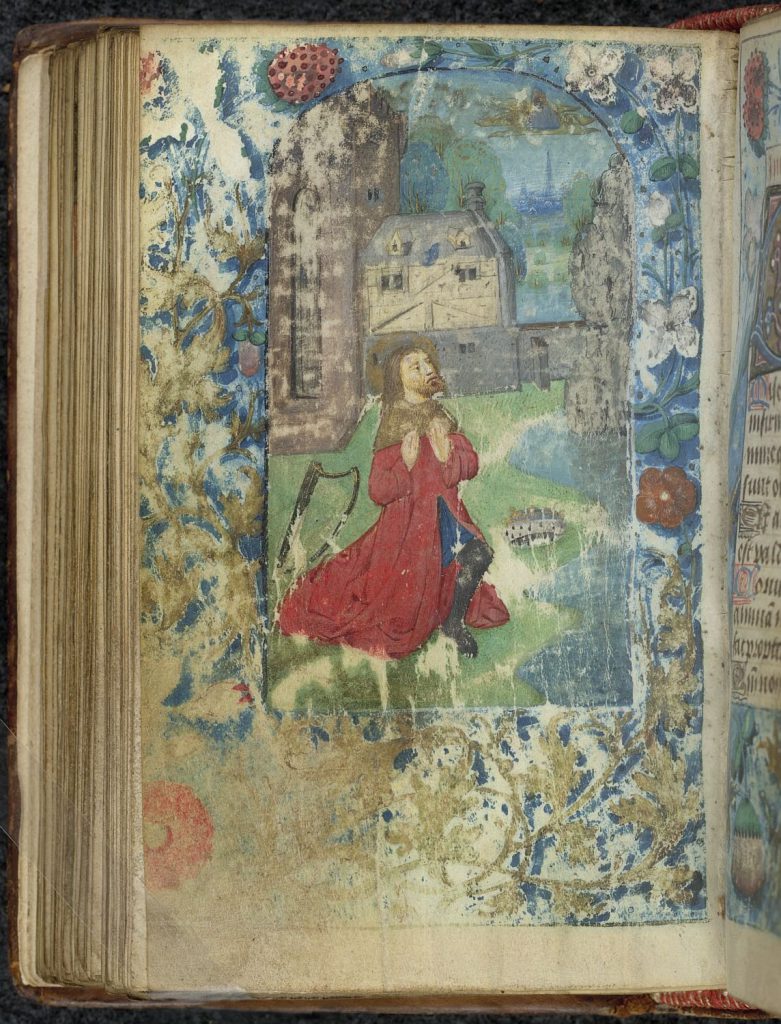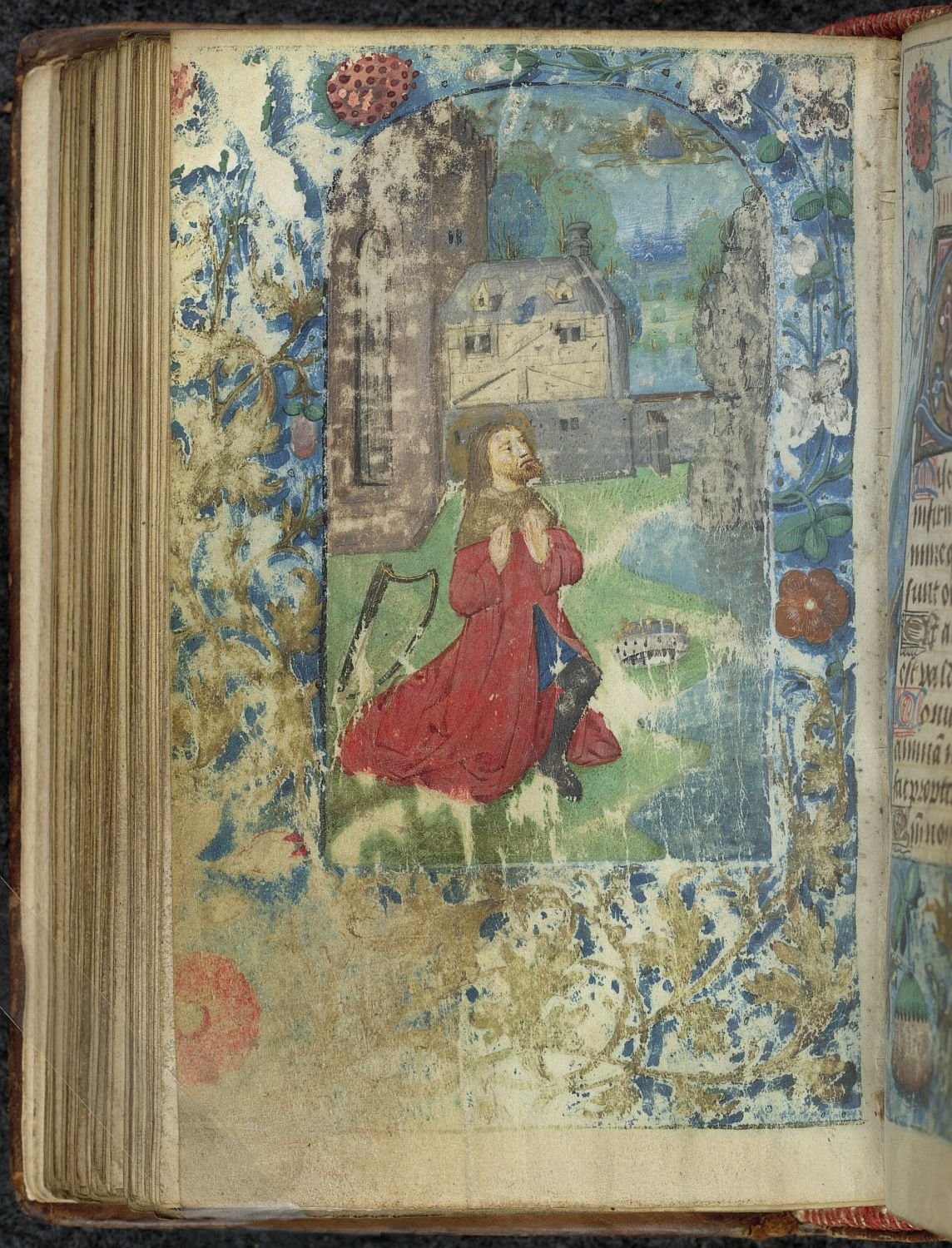
Books of Hours are primarily anthologies of prayers. They are handbooks for how to address the Divine, providing tried-and-true scripts for how to catch His ear. The tricks are many: praying in the voice of the penitent Psalmist, asking Mary to intercede on your behalf, or casting your precatory net as widely as possible in the Litany.
But these prayers are weird things to teach in an English department. First, they have no author, nor is there any authorial /I/ behind them; although we medievalists are used to teaching anonymous texts, we often still act in the classroom as though romances like Sir Gawain and the Green Knight or the saints’ lives in the South English Legendary are the product of a single mind (even when, as in the case of the SEL lives, they may not have been). Not only are the original compilers of these prayers lost in the mists of time, but the prayers are mash-ups of biblical phrases and liturgical tags that stage themselves as intrinsically author-less. They need not to have an author whose voice is heard in the prayerful /I/ so that the pray-er can inhabit that first-person position. Or, when they do have a pre-established /I/ (as in the Psalms of David), the pray-er’s self becomes fused with the davidic speaker in curious ways.
Second, these texts are repetitive. How many Ave Marias get packed into the most simple round of prayers in a day? How many times will Mary be invoked as the Mother of God or the Queen of Heaven? As English teachers and English majors, we’re used to watching for the anomalous, the distinctive, or the rephrased-with-new-meaning. We value originality, novelty, inventiveness. There’s little of that going on in the Hours of the Virgin or the Penitential Psalms, though. Rather, these prayers’ power and utility comes from their reiteration, on the regular voicing of the same words over and over again.
Third, these texts are – dare I say it? – boring. There is no narrative, no change over time. Nor is there an intriguing, developing interpersonal situation clearly embedded in the words of these prayers, as we can find in the sonnets of Petrarch. (Well, there is — it’s between the pray-er and God, but that’s not necessarily as compelling a relationship for most students as that of Dante and Laura.) Nor can we easily access their melodious play of sound and rhythm, except for the few who have had enough Latin schooling to be able to voice the original prayers smoothly.
I believe there is great pedagogical and interpretive potential in tackling these features of medieval prayer head-on. They are a different sort of utterance than everyday speech, so they encourage us to ask different sorts of questions: about how words, phrases, and sentences work; about how a prayer (not unlike some kinds of lyric) needs the speaker to inhabit its first-person position; about the relationship of the mortal to the divine, and of mortals through time. I also happen to think that, if we can understand better how these standard prayers function as literary texts, we’ll be in a better position to appreciate some of the more “foreign” or “unappealing” medieval literary works (the religious poetry of John Lydgate, for example). But it takes a different toolkit to be able to do that, one that I’m still pulling together for myself.
Today in class, I piloted the idea of these books of hours as encoding “ritual prayer.” I distinguished “ritual prayer” as pre-scripted prayer said over and over again, often by many different people across space and time, as opposed to “inventive” or “spontaneous” prayer, prayer as the soul’s outflowing of presumably heartfelt spiritual needs. I like approaching these prayers through the lens of ritual (however loosely I am using the concept – an issue I need to address), because it helps us focus on these prayers as performance. Their power lies in the outward, vocalized, and somatic actions of the pray-er, repeated through time.
And the class conversation was lively and wide-ranging. Students noted the analogical nature of this kind of prayer, the way that the praying /I/ becomes fused with all other speakers of these words, past and present; its communal and community-forming nature, even when said solo in the privacy of one’s closet; the need (or not) to know the literal meaning of the Latin words you’re saying, not just their jist. (We almost went to the problem that Chaucer’s “Prioress’s Tale” stages: must the pray-er be able to “expounde” the “mateere” that he or she intones, or is the devotional intent sufficient? [PriorT 536]). We didn’t focus as much on the full-body experience of prayer as I had anticipated — I had assigned Book 1 of the Ancrene Wisse, in which praying the Hours is an intensely somatic action — but we did consider extensively the role of vocalization in prayer, the critical role that speaking aloud in community plays in the very design of the Hours. Equally intriguing (and something I had not anticipated before class) was the idea of the witness: to say the Credo or to vocalize a prayer aloud and in front of others is to own that devotional stance personally. It’s not so much that the outward performance of prayer trumps the individual intention of the pray-er, but that these prayers are designed to foreground their public and collective nature.
I do wish we had spent more time on the way that this kind of prayer governs the soul from the outside — that is, the way that the repetition of prayers and gestures are designed to shape the inner self’s intentions, rather than being an expression of inward impulses — and its physiological expression, in kneeling and bowing, in holding a book and even kissing it. This idea of governing the internal self through the policing of outward motions is an important element of this kind of prayer.
And it also helps to explain certain features of wear and tear in the medieval books themselves. I love the intense wear on this miniature of David, which opens the Penitential Psalms in British Library, Arundel MS 316, a c. 1480 Book of Hours from Bruges or Ghent. Unlike some miniatures in which the face of Christ has been literally kissed away, this miniature’s degradation seems to come from more mundane handling: the borders are worn totally away in the lower corner, where the page would have been touched the most, and the crazing lines that run vertically through the water indicate that this page was turned a lot. The only other miniature from this Book of Hours that the British Library has imaged is one of the Virgin and Child, the naked baby Jesus standing to kiss Mary (fol. 31v, opening the Mass of the Virgin). On that image, Jesus’s face and the lower corner of the page do show significant wear, but not as much as the miniature for the Penitential Psalms. This admittedly limited evidence (oh, to see the rest of the manuscript!) suggests that the repentant voice of the Psalmist drew the medieval user’s interests more frequently than the scripted liturgical discourse of the Mass of the Virgin — a pattern of use that aligns with other Books of Hours in which the Penitential Psalms got much attention. [1] And the medieval use of these prayers left visible marks not only on the book’s body, but on the body of the pray-er as well.
[1] Kathryn M. Rudy, “Dirty Books: Quantifying Patterns of Use in Medieval Manuscripts Using a Densitometer.” Journal of Historians of Netherlandish Art 2.1-2 (2010). DOI: 10.5092/jhna.2010.2.1.1. Online at http://www.jhna.org/index.php/past-issues/volume-2-issue-1-2/129-dirty-books.
Postscript! See also the follow-up post on sound, liturgy, and the October 2016 issue of Speculum.
